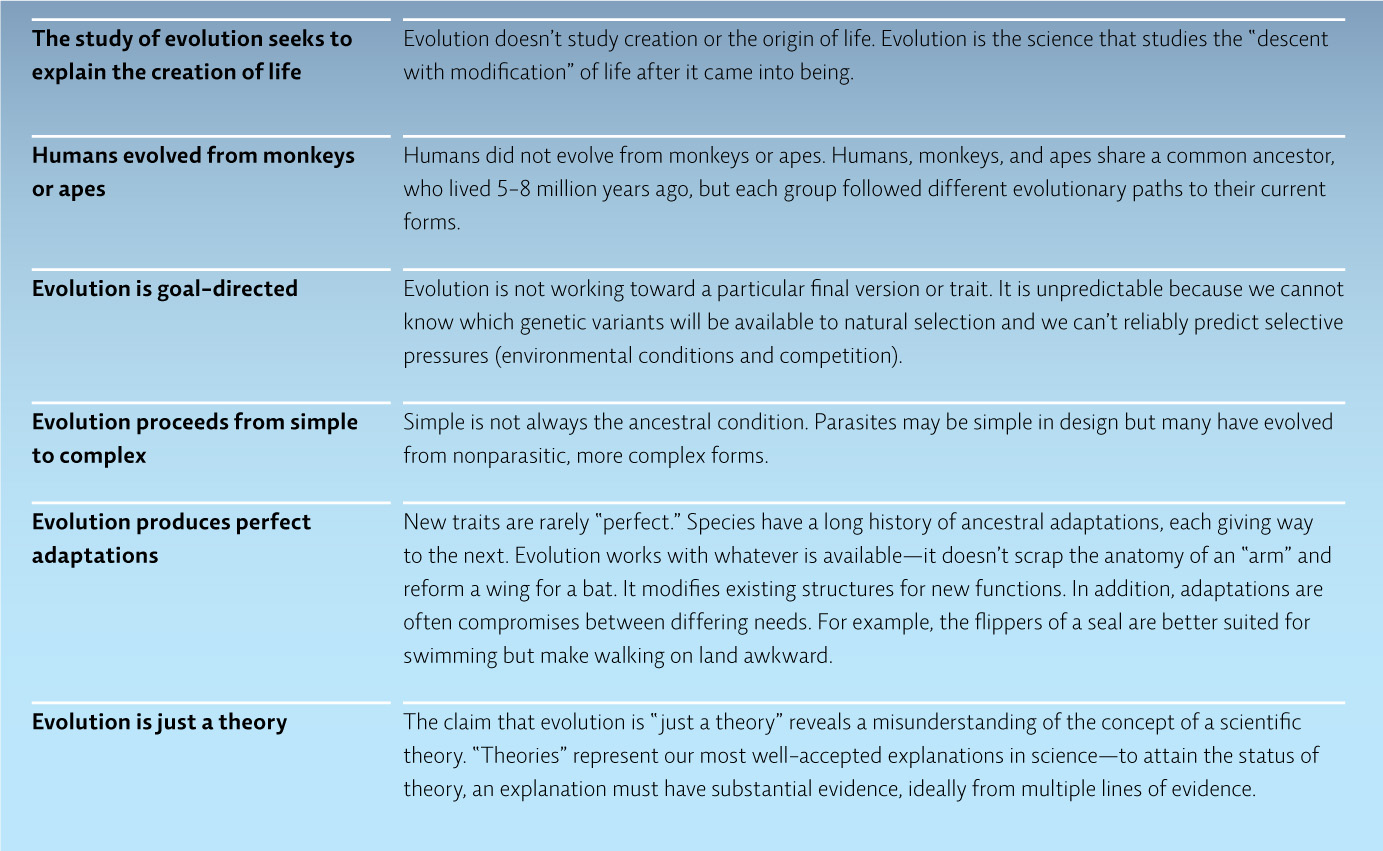10.8 Humans affect evolution in a number of ways.
The introduction of the brown tree snake to Guam was an accident: a snake hitchhiker crossed the ocean on a human tanker—unbeknownst to the crew—and landed in a veritable bird buffet. But humans also directly affect the evolution of a population through artificial selection. Artificial selection works the same way as natural selection but the difference is that the selective pressure is us. For many animal species, from pets to farm animals and plant species, humans choose who breeds with whom in an attempt to produce new individuals with the traits they desire. By doing this over many generations, people have accentuated certain plant and animal traits, sometimes to extremes. For instance, artificial selection created domestic dogs from their wolf ancestors. [infographic 10.7]

180
181
But evolution is ever at work. Pesticide- and antibiotic-resistant populations can emerge as an inadvertent human-influenced selection. When we apply a chemical that kills a pest or pathogen, some individuals survive because of their natural genetic resistance (the individuals were already resistant even though they had never encountered the chemical). These survivors are then the only individuals who reproduce, producing the next generation that is also pesticide resistant, ultimately changing the frequency of resistant genes in the population (see Chapter 18).
Evolution can be a contentious subject for some people who feel it conflicts with other views they hold. Whether or not you are convinced by the physical, scientific evidence that evolution has occurred or that natural selection is a mechanism by which it occurs, it is important that you base your criticisms of the theory on sound science and not on misconceptions of evolutionary theory. [infographic 10.8]

Ultimately, by changing the environment rapidly, humans apply a number of new selective pressures on populations. Our changes have the capacity to be so great that natural selection simply cannot keep up—new needed traits are not present in the population or cannot spread quickly enough to prevent a population collapse. The accidental introduction of the predatory brown tree snake is one such example; it introduced a major change, basically overnight, that was able to eat its way through the vertebrate populations before those populations could adapt.
Now, however, things are looking up for birds in Guam. Thanks to efforts by the Guam Department of Agriculture and the United States Department of Agriculture Wildlife Services, brown tree snakes are being controlled to allow bird populations to recover. “We are using traps in northern Guam to control snakes in areas where we would like to reintroduce native species,” explains Diane Vice, a wildlife biologist with the Guam Department of Agriculture. Her organization is also working to prevent the snakes from infiltrating Cocos Island, the atoll off of southern Guam that is an important haven for nesting sea birds, Micronesian starlings, and sea turtles. “The hope is to create safe habitat,” Vice says, so that these beautiful native species can once again thrive.
Select references in this chapter:
He, F., and Hubbell, S.P. 2011. Nature, 473: 368–371.
Owens, I.P.F, and Bennett, P. 2000. Proceedings of the National Academy of Sciences, 97: 12144–12148.
Pimm, S., et al. 1995. Science, 269: 347–350.
Savidge, J.A. 1987. Ecology, 68: 660–668.
BRING IT HOME: PERSONAL CHOICES THAT HELP
The astonishing variety of life found on Earth is the result of natural selection favouring those individuals within populations that are best able to survive in their particular environment. Given enough time, some populations may be able to adapt to environmental changes. However, human activities may disrupt natural ecosystems so that organisms cannot adapt fast enough to survive, and may go extinct. Conservation activities can help protect vulnerable organisms and ecosystems.
Individual Steps
 Live in an older, established area of your community. Suburban sprawl reduces habitat for wildlife, and reliance on cars causes greenhouse gas emissions that could result in species-threatening climate change.
Live in an older, established area of your community. Suburban sprawl reduces habitat for wildlife, and reliance on cars causes greenhouse gas emissions that could result in species-threatening climate change.
 Save your pocket change and at the end of every year donate the money to a land, marine, or wildlife protection agency.
Save your pocket change and at the end of every year donate the money to a land, marine, or wildlife protection agency.
 Create a personal blog that includes photographs of wildlife, facts about current threats to plants and animals, and articles about conservation.
Create a personal blog that includes photographs of wildlife, facts about current threats to plants and animals, and articles about conservation.
Group Action
 Throw a party in support of wildlife conservation. Take a collection at the door and donate the money to an organization that supports conservation.
Throw a party in support of wildlife conservation. Take a collection at the door and donate the money to an organization that supports conservation.
Policy Change
 “Adopt an Organism.” Species at Risk Public Registry maintains a list of endangered plants and animals across the country. Research this list to find wildlife that interests you. Determine what agency, conservation group, or legislator you could contact and then start your own protection campaign. See what meetings, petitions, and legislation could impact your organism and get involved.
“Adopt an Organism.” Species at Risk Public Registry maintains a list of endangered plants and animals across the country. Research this list to find wildlife that interests you. Determine what agency, conservation group, or legislator you could contact and then start your own protection campaign. See what meetings, petitions, and legislation could impact your organism and get involved.

182